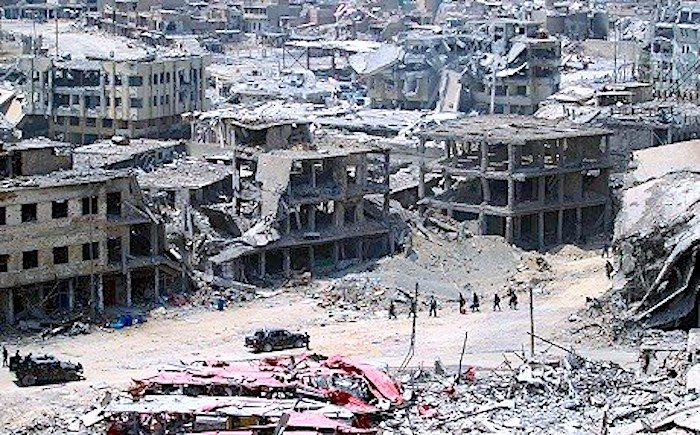A US-led coalition bombed key targets in what were described as "pinpoint airstrikes" by Michael Fallon, who was then the UK's defence secretary, when the city was finally liberated last July.
The RAF struck more than 750 targets during the campaign to liberate the city, second only to the US, according to the Ministry of Defence.
But a survey of around 1,200 households in the city shows that mortality rates among civilians increased nearly 13 times during the battle to liberate Mosul.
The study, published in the journal PLOS Medicine, showed that 505 civilians died from what the researchers called intentional violence. The leading cause of violent death during the period studied was air strikes, accounting for 201 civilian deaths, followed by 172 deaths from explosions.
The survey revealed that there had been seven beheadings, a favoured method of execution by Isil. Some 15 people died from gunshot wounds, with numbers higher in the west of the city - this would chime with reports of snipers, the study said.
The authors of the paper said it was impossible to extrapolate the total number of civilians killed during the occupation and liberation from their study because the west of the city was more heavily bombarded than the east. "This would make wider population estimates of mortality for Mosul more uncertain," the paper stated.
The interviews - carried out by four Iraqi doctors - took place after many civilians had fled the city, adding to the uncertainty around numbers, the paper said.
However Gilbert Burnham, the study's lead author and co-director of the Center for Refugee and Disaster Response at Johns Hopkins University, said the research showed that targeting jihadists by air was not as accurate as the coalition forces claimed.
"The high velocity, high explosive weapons have a huge range and using these weapons in tightly packed urban areas is a major risk. You might be targeting snipers or a group of [Isil] fighters but if they're closely surrounded by large numbers of civilians you can expect substantial casualties," he said.
He added: "There's always collateral damage and that's recognised in the Geneva Convention and in warfare. But the more powerful the weapons become, the larger the area of potential collateral damage. That raises a whole question of proportionality."Major General Rupert Jones, deputy commander of the Combined Joint Taskforce to free the city called the battle "the toughest urban combat that has probably been fought since the Second World War". Civilians were advised to stay in their homes although up to around one million fled the city during the battle.
A report into the toll of the liberation on civilians by human rights organisation Amnesty International highlighted the violations committed by Isil, including the use of thousands of civilians as human shields. It said the group "summarily killed hundreds - if not thousands - of men, women and children as they attempted to flee and hanged their bodies in public areas". Civilians were also denied access to medical care and food and their only option was to escape through the front lines of the fighting, said the report.
But the report also highlighted the number of civilians who died in coalition-led airstrikes. It investigated 45 attacks in West Mosul which it said killed at least 426 civilians.
Chris Woods, director of Airwars, an independent research group which monitors casualties inflicted by both coalition and Russian forces in Syria and Iraq, said "a significant number of civilians were killed" by Isil in Mosul. But he added that the airstrikes also claimed many lives.
"Britain has been bombing in Iraq and Syria for four years and has conceded one fatality from 1,600 airstrikes. That's science fiction warfare." Most civilians are dying in basements and simply because you cannot observe them it doesn't mean we're not harming them," he said.
A statement from the Combined Joint Taskforce, the coalition which led the airstrikes, said it sought to minimise risks to non-combatants.
"The coalition always seeks to use weapons that are proportional to the target to minimise collateral damage and risk to civilians. We have gone so far as to abort missions in progress when there was an unacceptable level of risk of civilian casualty.
"The coalition has done, and continues to do, everything within its power to limit harm to non-combatants and civilian infrastructure."




Comment: More harm than good? While the data is imperfect, the premise is as alarming as it is justified. If Mosul is any coalition example, expect little difference in change of action or outcome in other conflicts. War is never about saving the innocent.
See also: